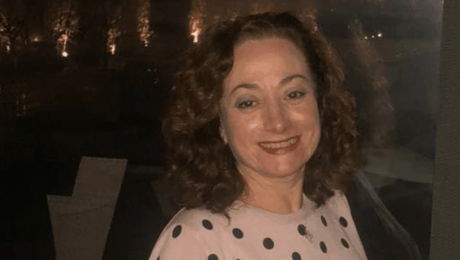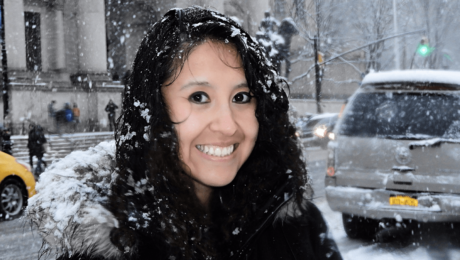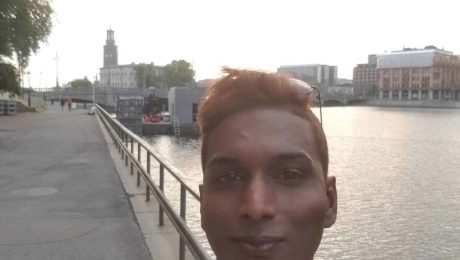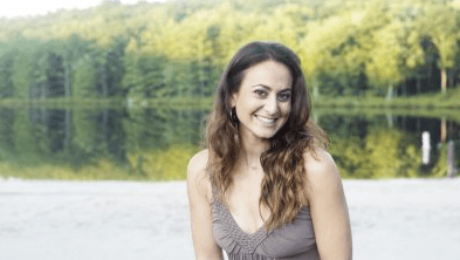The Collective Effervescence from dancing together!
There’s nowhere in the world where there is a culture that doesn’t move to music. This video presents research about the Collective Effervescence of dance and helps explain why there is so much joy in the air when 10,000 dancers come together in the Annual Dance Parade and Festival.
This video explains why dance has become a human necessity in the gluing of societies together:
 The French sociologist Émile Durkheim (1858-1917) theorised that ‘collective effervescence’ — moments in which people come together in some form of unifying, excitement-inducing activity — is at the root of what holds groups together. More recently, Dr. Bronwyn Tarr, an evolutionary biologist and psychologist at the University of Oxford who is also a trained dancer, has researched the evolutionary and neurological underpinnings of our innate tendency to bust a move.
The French sociologist Émile Durkheim (1858-1917) theorised that ‘collective effervescence’ — moments in which people come together in some form of unifying, excitement-inducing activity — is at the root of what holds groups together. More recently, Dr. Bronwyn Tarr, an evolutionary biologist and psychologist at the University of Oxford who is also a trained dancer, has researched the evolutionary and neurological underpinnings of our innate tendency to bust a move.
Photo credit: Miguel Chavez
Drawing on the work of both Durkheim and Tarr, this Aeon Original video explores that unifying feeling of group ‘electricity’ that lifts us up when we’re enthralled by our favourite sports teams, participating in religious rituals, entranced by music – and, yes, dancing together at the Annual Dance Parade New York.
You can read more about Durkheim and his work here and about Dr. Tarr’s work here.

The Annual Dance Parade, with over 100 unique forms of dance, is an accelerator of Collective Effervescence, gluing society together.
Photo credit: Glenmore-Marshall
One hypothesis is that it provides an opportunity for people to come together, making them move — dance — and in doing so we experience internal hormonal cascades which are made up of ‘feel good’ chemicals. These bursts of chemicals are part of our brain’s pain and pleasure and reward circuitry, and when they are triggered they provide an experience of elation and positive reward. When we get this kick in the presence of others, the result is that of collective joy — positive, shared experiences through which we establish and maintain important social connections with others. Now we feel like we belong to a unified, cohesive whole.
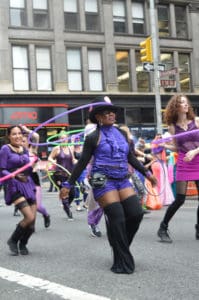
Being part of a cohesive social group would have been really important for our ancestors — collaborating with others to find shelter, hunt, rear young would have increased our chances of survival. Music and dance are by no means the only ways we can stimulate these positive social ‘highs’. But they’re really good ways of doing it because it’s an experience that we can share with lots of people at once. In order to understand why that would have given us such a great advantage we need to look at our species in the context of primates.
Photo Credit: Chris Fernando
Get Social with Dance Parade on:
Facebook
Instagram
YouTube
Learn more about our friends at Aeon
- Published in 2019
Volunteer Spotlight: Meet Mona Freeman
In each issue of our STEPS! Newsletter we try to cast the Spotlight on one of our awesome team members to find out more about where they came from and to suss out their connection to dance and supporting the Dance Parade team. In this issue, we put the spotlight on Mona Freeman.
Hi, Mona. Thanks for taking time out of your busy schedule to talk with us.
How did you first find out about Dance Parade?
 I saw a posting on LinkedIN last year and was intrigued by the idea of a dance parade.
I saw a posting on LinkedIN last year and was intrigued by the idea of a dance parade.
I love to create, direct and produce crowd pleasing entertainment and this seemed like a good match.
I sent a connection request to Greg Miller, the Executive Director of the nonprofit that produces Dance Parade, stating that I wanted to know more about the Dance Parade. However, I was not able to be a part of it in 2018.
This season, when the volunteer committee was looking for people to join, I answered the call!

What is your current role in Dance Parade New York?
I am on the Curation Committee, planning the Dance Festival which will take place in Tompkins Square Park following the parade. I am currently watching through videos of dance performances to decide where they will be placed in the festival. I will then be coordinating the groups who will be presented on the family stage. The family stage will be presenting most of the groups that are made up of youngsters. I have previously presented dozens of performances with a cast of hundreds of children as young as three years old through teens.
What is your favorite style of dance to watch? to participate in?
Musical Theater and Ballet. When I began my dance training, I was influenced by the Broadway show A Chorus Line and the movie The Turning Point. I’ve studied numerous forms of dance, but ballet is what keeps me coming back because there is always something new to achieve.
What is your dance background or interest in dance?
My first formal dance lesson was at the age of thirteen. I was a high school gymnast and joined a ballet class in order to supplement my skills. I soon realized that I enjoyed ballet far more than gymnastics. I studied Dance Education at New York University and established a private dance studio shortly after graduation. I directed and taught students three years old through adults in Ballet, Tap, Jazz for over three decades.
If you could share the stage with anyone in history famous or not, living or deceased, a trained dancer or not, performing a routine choreographed by yourself…who would it be?
Gene Kelly, he made it look effortless. I would dance with him in the ballet presented at the end of An American In Paris. It’s a classic and doesn’t need any improvement.

Last year we celebrated the repeal of the Cabaret Law with the theme “The Cabaret of Life” — What does this year’s theme “Movement of the People ” mean to you?
Dance has been a means of expression since the beginning of time. For some people it is a cultural experience, for others it is a social experience, and there are those who bring dance to the stage for artistic expression or purely to entertain. With Dance Parade New York, we celebrate all of these dancers.
What dance group or dance style are you most looking forward to seeing this coming year in the parade?

I am looking forward to seeing the community engagement groups who will be performing on the family stage. With these programs in schools and community centers throughout NYC, these youngsters and senior citizens have been exposed to something new. They learn tangible skills in movement and expression as well as intangible ones like confidence and team building. The final project of being in the parade and festival brings all this together. Some of them may be involved in dancing for the first time, or possibly since a long time ago. This is a wonderful experience for them, I want to share their joy!
If you could choose a Grand Marshal for this year’s parade….who would it be?
I would choose Rhee Gold. He is a source of motivation and encouragement for dance teachers and studio owners in the private sector. Rhee’s mother was a dance teacher. Rhee and his twin brother Rennie grew up in that world. Thousands of students attend dance classes each week where they not only learn dance technique, they learn life’s lessons.
Working for a non profit organization can at times be daunting and frustrating with limited personnel and funding….what is it that keeps you coming back for more and more?
When you are working on something that has personal meaning for you, the struggle is worth the trouble. I support the mission of Dance Parade: to promote dance as an expressive and unifying art form by showcasing all forms of dance, educating the general public about the opportunities to experience dance, and celebrating diversity of dance in New York City by sponsoring a yearly city-wide dance parade and dance festival.
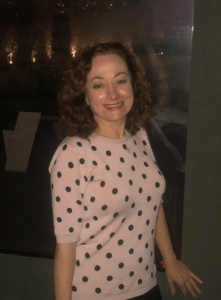
What pitch would you use to attract a new volunteer onto the Dance Parade team?
If you love dance and the unbridled freedom of dancing in the streets, you need to join us!
Thanks Mona–Folks who want to volunteer can click here to fill out our short form!
- Published in 2019, Team Spotlight, Volunteer Spotlight
Genre Buzz: Circle Dance, to start the 2019 Parade!
Circle dance is a style of dance done in a circle or semicircle to musical accompaniment, such as rhythm instruments and singing. Circle dancing is probably the oldest known dance formation and was part of community life from when people first started to dance.
Dancing in a circle is an ancient tradition common to many cultures for marking special occasions, rituals, strengthening community and encouraging togetherness. The dance can also be enjoyed as an uplifting group experience or as part of a meditation. Circle dances are choreographed to many different styles of music and rhythms.
Unlike line dancing, circle dancers are in physical contact with each other; the connection is made by hand-to-hand, finger-to-finger or hands-on-shoulders. It is a type of dance where anyone can join in without the need of partners. Generally, the participants follow a leader around the dance floor while holding the hand of the dancers beside them. The dance can be gentle or energetic.
Modern circle dance mixes traditional folk dances, mainly from European or Near Eastern sources, with recently choreographed ones to a variety of music both ancient and modern. There is also a growing repertoire of new circle dances to classical music and contemporary songs.
Culture
Modern circle dancing is found in many cultures, including Arabic (Lebanese and Iraqi), Israeli (see Jewish dance and Israeli folk dancing), Assyrian, Kurdish, Turkish, Armenian, Azerbaijani, Maltese, and South Eastern European (i.e. Albanian, Bosnian, Bulgarian, Croatian, Greek and Serbian, to name a few).
Despite its immense reputation in the Middle East and southeast Europe, circle dancing also has a historical prominence in Brittany, Catalonia and Ireland to the west of Europe, and also in South America (Peruvian), Tibet, and with Native Americans (see ghost dance). It is also used, in its more meditative form, in worship within various religious traditions including, the Church of England and the Islamic Haḍra dances.
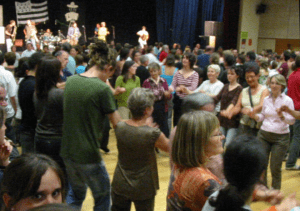 Western Europe: An-Dro
Western Europe: An-Dro
An Dro, meaning “the turn”, is a Breton circle dance. The dancers link the little fingers in a long line, swinging their arms, whilst moving to their left. The arm movements consist first of two circular motions going up and back followed by one in the opposite direction. The leader (person at the left-hand end of the line) will lead the line into a spiral or double it back on itself to form patterns on the dance floor, and allow the dancers to see each other.
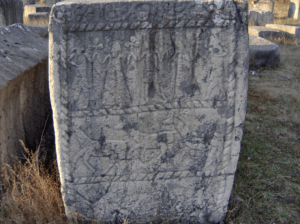 Thousands of medieval tombstones called “Stecci” were found in Bosnia and Hercegovina and neighboring areas. They dated from the end of the 12th century to the 16th century. They bear inscription and figures which look like dancers in a chain. Men and women are portrayed dancing together holding hands at shoulder level but occasionally the groups consist of only one sex.[4][5]
Thousands of medieval tombstones called “Stecci” were found in Bosnia and Hercegovina and neighboring areas. They dated from the end of the 12th century to the 16th century. They bear inscription and figures which look like dancers in a chain. Men and women are portrayed dancing together holding hands at shoulder level but occasionally the groups consist of only one sex.[4][5]
In Macedonia near the town of Zletovo, the murals on the monastery of Lesnovo (Lesnovo Manastir), which date from the 14th century, show a group of young men linking arms in a round dance. A chronicle from 1344 urges the people of the city of Zadar to sing and dance circle dances for a festival. However, a reference comes from Bulgaria in a manuscript of a 14th-century sermon, which calls chain dances “devilish and damned.”
 The hora dance originates in the Balkans but also found in other countries (including Romania and Moldova). The dancers hold each other’s hands and the circle spins, usually counterclockwise, as each participant follows a sequence of three steps forward and one step back. The Hora is popular during wedding celebrations and festivals, and is an essential part of the social entertainment in rural areas. In Bulgaria, it is not necessary to be in a circle; a curving line of people is also acceptable.[22]
The hora dance originates in the Balkans but also found in other countries (including Romania and Moldova). The dancers hold each other’s hands and the circle spins, usually counterclockwise, as each participant follows a sequence of three steps forward and one step back. The Hora is popular during wedding celebrations and festivals, and is an essential part of the social entertainment in rural areas. In Bulgaria, it is not necessary to be in a circle; a curving line of people is also acceptable.[22]Kolo
The kolo is a collective folk dance common in various South Slavic regions, such as Serbia, named after the circle formed by the dancers. It is performed amongst groups of people (usually several dozen, at the very least three) holding each other’s having their hands around each other’s waists (ideally in a circle, hence the name). There is almost no movement above the waist.
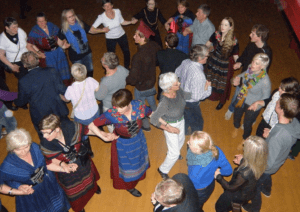 Faroese dance
Faroese dance
The Faroese dance is the national circle dance of the Faroe Islands. The dance originated from the medieval times, which survived only in the Faroe Islands, while in other European countries it was banned by the church, due to its pagan origin. The dance is danced traditionally in a circle, but when a lot of people take part in the dance they usually let it swing around in various wobbles within the circle. The dance in itself only consists in holding each other’s hands, while the dancers form a circle, dancing two steps to the left and one to the right wirhout crossing the legs. When more and more dancers join the dance ring, the circle starts to bend and forms a new one within itself.
Sacred Circle Dance
The Sacred Circle Dance was brought to the Findhorn Foundation community in Scotland by Bernhard Wosien who brought traditional circle dances that he had gathered from across Eastern Europe.
Colin Harrison and David Roberts took the dances to other parts of the UK where they started regular groups in south east England and Somerset, then across Europe, the US and elsewhere. The network extends also to Australia, New Zealand, South Africa and South America and India.
A small centrepiece of flowers or other objects is often placed at the centre of the circle to help focus the dancers and maintain the circular shape. Much debate goes on within the sacred circle dance network about what is meant by ‘sacred’ in the dance.
Dabke
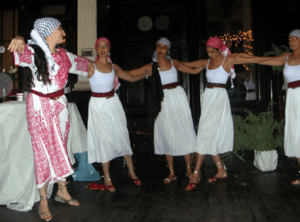 Dabke is popular in Lebanon, Syria, Palestin, Israel, Jordan and Turkey. The most famous type of the dance is the Al-Shamaliyya (الشمالية). It consists of a lawweeh (لويح) at the head of a group of men holding hands and formed in a semicircle. The lawweeh is expected to be particularly skilled in accuracy, ability to improvise, and quickness (generally light on his feet). The dancers develop a synchronized movement and step, and when the singers finish their song the lawweeh breaks from the semicircle to dance on their own. The lawweeh is the most popular and familiar form of dabke danced for happy family celebrations.
Dabke is popular in Lebanon, Syria, Palestin, Israel, Jordan and Turkey. The most famous type of the dance is the Al-Shamaliyya (الشمالية). It consists of a lawweeh (لويح) at the head of a group of men holding hands and formed in a semicircle. The lawweeh is expected to be particularly skilled in accuracy, ability to improvise, and quickness (generally light on his feet). The dancers develop a synchronized movement and step, and when the singers finish their song the lawweeh breaks from the semicircle to dance on their own. The lawweeh is the most popular and familiar form of dabke danced for happy family celebrations.
Ganggangsullae (강강술래)
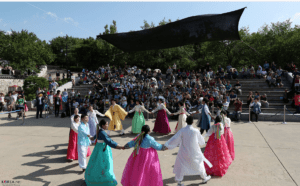
Ganggangsullae is an ancient Korean dance that was first used to bring about a bountiful harvest and has developed into a cultural symbol for Korea. It incorporates singing, dancing, and playing and is exclusively performed by women. The dance is mostly performed in the southwestern coastal province of Jeollanam-do. It is often associated with the Chuseok holiday and Daeboreum.
The next time you see a Circle Dance, join in — It’s fun and you will be participating in an ancient cultural tradition!
Article Source: Wikipedia (English version)
- Published in 2019, Genre Buzz
Meet Paul, Actor, Skater and Bubble Performer!
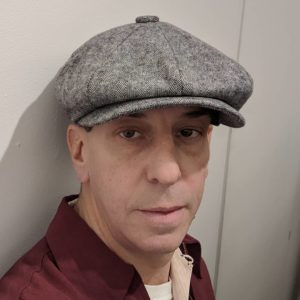
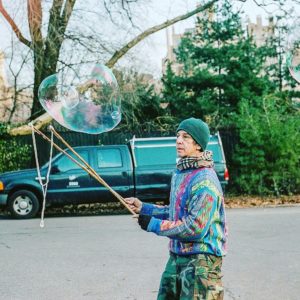
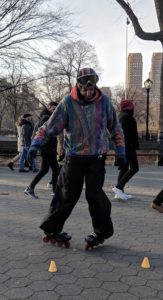
If you could share the stage with anyone in history famous or not, living or deceased, a trained dancer or not, performing a routine choreographed by yourself…who would it be?
I would share the stage with my nephew Forrest Charles. (Or my 2nd choice is my cousin, Jacob Reiben)
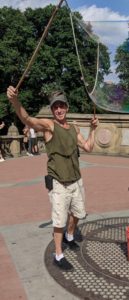
There are over 100 groups signed up so far and over 60 unique styles of dance. What dance group or dance style are you most looking forward to seeing this coming May 18th in the parade?
I am most interested in the dance styles chosen by the children. Then by any dance skaters, break Dancers, and anyone else who wants participate because I will be cheering them on.
If you could choose a Grand Marshal for this year’s parade….who would it be?
If you could pick another country to hold a Dance Parade and Festival….which would it be?
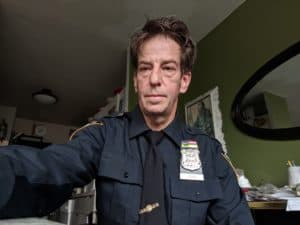

Working for a non profit organization can at times be daunting and frustrating with limited personnel and funding….what is it that keeps you coming back for more and more?
- Published in 2019, Team Spotlight
Meet Nhadyr, a passionate volunteer set on sharing Dance Parade Love with the Spanish Press!
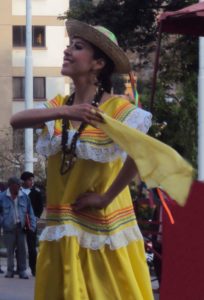

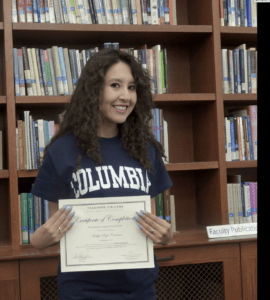
What is your favorite style of dance to watch? to participate in?
Well, when we talk about dance we are talking about many things… Technique, style, choreography and so on but the most important thing, in my opinion, is the feeling. I don’t really have a favorite style of dance, however, I love seeing when someone is enjoying the dance, if they can make me feel what they feel while dancing, I think they did everything.
About participating, I love my Bolivian rhythms. We have so much variety and what I think I love the most is that every rhythm has its meaning, they all come from ancient times and every movement we do denotes something important.
I don’t think my culture is the best over the world, because every country has a story to tell through their dances. So, I always try to learn as much as I can about other cultures. I could dance from Peruvian music to Polish, if they teach me, without any problem.
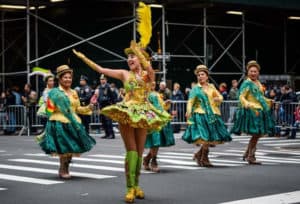
What is your dance background or interest in dance?
I’ve been involved in music ever since I can remember. My father is a music lover and grew up listening to all kinds of music all the time and as soon as I learned how to stand, I started dancing. I used to dance with my parents at home to all kinds of rhythms, most of all, the Latin-American ones. Then, when I turned 13, I started my folkloric dancing classes and ever since the moment I started, I couldn’t leave those traditions anymore. I’ve been dancing Bolivian folkloric dances for almost 16 years now.
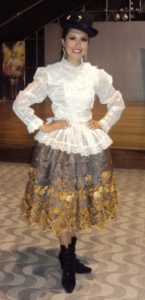
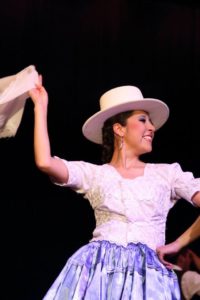
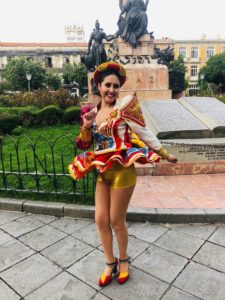
If you could share the stage with anyone in history famous or not, living or deceased, a trained dancer or not, performing a routine choreographed by yourself…who would it be?
This is a hard question but I think Michael Jackson is such a complete and multi-talented artist, not only an excellent musician but also an amazing dancer.
Last year we celebrated the repeal of the Cabaret Law with the theme “The Cabaret of Life” — What does this year’s theme “Movement of the People ” mean to you?
I think this year’s theme shows what NYC has to offer. I mean, there are over 1,000 cultural organizations in the five boroughs that show the diversity of culture that defines NYC and close to 200 organizations will be in the parade.
What dance group or dance style are you most looking forward to seeing this coming year in the parade?
Actually, this is going to be my first Parade, so I am excited to see everything and everyone. I understand that there will be over 80 unique styles of dance and I like the idea of the “United Nations of Dance!”

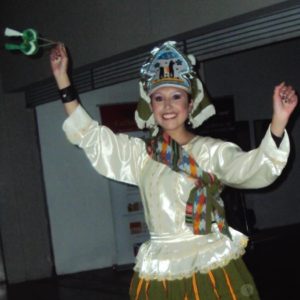
If you could choose a Grand Marshal for this year’s parade….who would it be?
It is very difficult to pick a representative to represent all of dance but it would be nice to have Major Bill de Blasio make an appearance! As we’re beginning the parade with a Native American Circle Dance, how nice would it be for him to join the 20 to 30 other representatives from the parade for the celebration of unity and diversity, honoring the indigenous peoples before us and also showing support for immigrant rights.
If you could pick another country to hold a Dance Parade and Festival….which would it be?
Japan! Through my experience with my Bolivian music and dance, I’ve learned that Japanese people are very interested in new culture and rhythms. With my involvement with the Bolivian events, some of them are not only audience members but also are performers in music and dance.
In fact, one of our most representative folkloric group called “Los Kjarkas” has a member that was born in Japan. Makoto ShiShido plays the Charango, which is a native instrument that resembles a smaller version of a guitar with twice as many strings.
Besides Makoto, there are some Orchestras with Japanese musicians that play Bolivian music, they even travel to Bolivia every year to study more about the rhythms and are often accompanied by Japanese dancers doing Bolivian rhythms. One of the directors of these Orchestras is Sho Makino. Sho just finished his master thesis in Bolivian Ethnomusicology in Japan.
Because of these reasons, I would choose Japan to hold a Dance Parade and Festival.
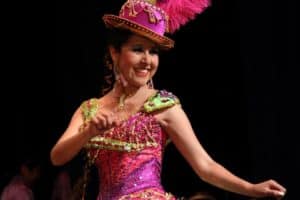
Working for a non profit organization can at times be daunting and frustrating with limited personnel and funding….what is it that keeps you coming back for more and more?
Working for a non-profit organization definitely has its challenges, but is very rewarding. There is something besides money that moves us to continue. In my case, the love of culture, music, dance, art, makes me work with so much passion and makes me happy, and for me, that’s more important than financial reward.
- Published in 2019, Press, Team Spotlight
Meet Julian, producing Dance Parade with Pride!
Dance Parade, Inc. is a non-profit organization supported by a passionate team of dance lovers! It is the dedication, expertise and rhythm of these hard-working team members that contributes to the success of Dance Parade, DanceFest and the Community Engagement Programs. Want to join the team? Click here! This month we sat down with Julian Sanjivan (Pronouns They/Them/Theirs)
Hey Julian, thanks for taking the time to tell us about yourself.
I was looking to do something during my free time and stumbled upon the Dance Parade on LinkedIn. I decided to apply for the Parade Production Lead role. So, your current role in Dance Parade, Inc would be? Parade Production Lead. I actually am also the Director of the Pride March. I am enjoying working with Adele Godfrey, a talented producer who has 3 Dance Parades under her belt.
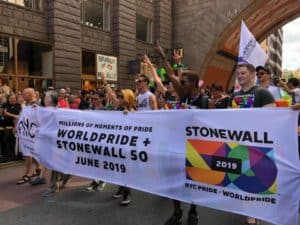
What is an asylee?
An asylee is what you call someone who seeks asylum. The organization that I co-founded is called “Asylee Designs” We want to improve how we welcome and learn from newcomers in New York City.
Wow, that kind of work is so needed under the current government climate. Thanks for doing that!
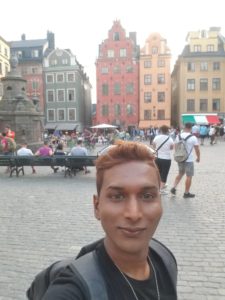 Now, turning to dance. What is your favorite style of dance to watch? to participate in?
Now, turning to dance. What is your favorite style of dance to watch? to participate in?Anything contemporary.What is your dance background or interest in dance?
I performed contemporary when I was in college. I still am interested in contemporary. However, I am interested to watch any types of dance.
If you could share the stage with anyone in history famous or not, living or deceased, a trained dancer or not, performing a routine choreographed by yourself…who would it be?
This may sound cliche but I would probably like to share the stage with Jennifer Lopez, Madonna, or Lady Gaga.
What does this year’s theme “Movement of the People” mean to you?
The current administration in the White House has been contentious and very divisive. This year’s theme is timely in bringing people together by celebrating something many love: Dance!
What dance group or dance style are you most looking forward to seeing this coming year in the parade?
Belly dancing! I would like to see how they are able to do this down the parade route!
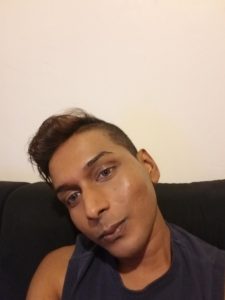
If you could pick another country to hold a Dance Parade and Festival….which would it be?
I am originally from South East Asia. I would naturally be biased in recommending one of the culturally diverse South East Asian countries like Thailand, Malaysia, Singapore, Indonesia, or the Philippines.
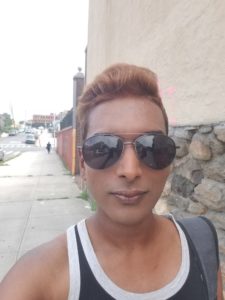
Working for a non-profit organization can at times be challenging with limited personnel and limited funding….what is it that keeps you going?
This is my first time with the Dance Parade. So, I can’t really say. However, I have volunteered for other events. The thing that makes me come back for more is the satisfaction of organizing something monumental for the community that thrives from such an event and working with a great team.
- Published in 2019, Team Spotlight
Team Spotlight: Meet Janelle, Parade Programming Lead!
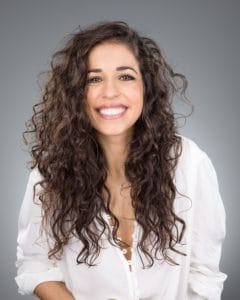
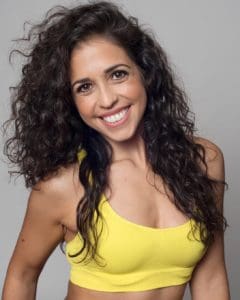
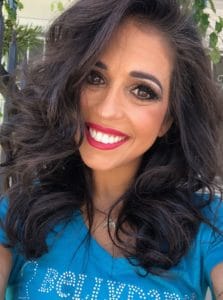
- Published in 2018, 2019, Team Spotlight
Team Spotlight: Meet Adele, Parade Production Lead!
Let’s start at the very begin shall we?
How did you first find out about Dance Parade?
I first heard of dance parade through my friend Erik. He introduced me to the parade and got me involved the first year as a NYDP officer (New York Dance Police). It was the perfect first experience to ticket people for NOT dancing!
What is your current role in Dance Parade, Inc?
Currently I lead a production team that plans and produces the parade. I’m here to help make sure the day of the parade runs smoothly.
What is your favorite style of dance to watch? to participate in?
I love watching expressive, modern dance; I love when people can tell a story through dance. I also really enjoy watching couple dance whether it be salsa, samba, swing or modern. The connection of two dancers performing is so captivating.
I participate in non-traditional forms of free form dance… including 5Rhythms. Anywhere there is good music you will find me dancing… whether there is a dance floor or not. I’ve never performed any type of dance routine for a formal audience.
What is your dance background?
After studying business management in college and then working in an office job I knew there was something more to a job. So I quit my business job and went to photo school. After learning all the techniques and the business of photography I moved to NYC to start my career. Along the way I found my passion for photographing babies and children and now specialize in children’s fashion photography as well as photographing newborns and family portraiture. I am available for personal and commercial shoots: adele@adelegodfrey.com. You can check out some of my work at: www.adelegodfrey.com.
What is your interest in dance?
I’ve taken only a handful of formal dance classes, but I grew up belly dancing and salsa dancing within my community. Now I am a regular at 5 rhythms and continue to create uplifting dance energy where ever dancing is appropriate.
If you could share the stage with anyone in history famous or not, living or deceased, a trained dancer or not, performing a routine choreographed by yourself…who would it be?
Shakira! She’s an amazing dancer and she can rock the hips the way a Lebanese (even half) woman should. She not only dances for her audience and her songs, but I’ve seen some beautiful serene dance sequences she’s be a part of and it’s magic. You can’t help but be mesmerized by her moves.
What does this year’s theme “The Cabaret of Life” mean to you?
Don’t let life hold you down, but find the freedom to dance… even if it’s just in your room by yourself. Dancing releases so much stress and anxiety, it allows us to embrace our connection with our body and feel free, even if just for a few moments. During dance we can put our troubles and pessimistic thoughts aside while our bodies move to find the release and freedom from those damaging thoughts. Many people are afraid to let themselves go to feel the freedom dance allows. This year’s theme challenges those who may not feel free to let that go and let themselves dance to feel the freedom. It promotes the idea of living free and connecting that with dance! Dance more is my resolution for the new year. I always feel great after a good dance session.
What dance group or dance style are you most looking forward to seeing this coming year in the parade?
I’m looking forward to seeing the performances of the underprivileged kids that dance parade brings classes to. From what I understand there are some kids who are taught a routine that will be showcased in the parade. I thing this is an amazing thing Dance Parade participates in that is a benefits for kids not just on this day, but ongoing. There is also this swing dancing group that I saw last year who were just amazing! They are enjoyable to watch and I look forward to seeing what they are bringing this year.
If you could pick another country to hold a Dance Parade and Festival….which would it be?
Good question! Another country… how about Southern California… ok that’s not a different country, but sometimes it feels like it is. Paris would be my other country pick. Why? It’s pretty and will make pretty backgrounds for photos as people are parading around town. 🙂
Supporting a non profit organization can at times be daunting with limited personnel and limited funding….what is it that keeps you coming back for more and more?
It is frustrating with the limited amount of time I have that I can spend with volunteering. I’m back for the first time and not sure exactly how much is going to be expected from me. I’ll let you know next year why I will return, if I do return…haha 😉
The reason I joined this year is because I feel moved by the awesomeness of the parade and festival (and I’m not the kind of person who usually enjoys parades.) But this parade has such an uplifting energy throughout…it’s not just people solemnly walking or marching, but its an environment where people are smiling, laughing, stylishly moving and connecting all through the love of dance. The love of dance brings together people of all ages, backgrounds, races and colors and it’s just beautiful to witness and experience. This is why I am involved.
Describe a special memory you have from Dance Parade’s past?
Little moments happened last year when I was a dance police (which is the most awesome addition to the parade by the way)…I saw this older gentleman just sitting and watching the parade looking so bored and disinterested, not smiling or anything… I went up to him and said sternly, “You are in violation for not smiling and not dancing!” Right away he perked up smiled and started moving his body, saying “No, no I’m dancing… see?” I gave him a citation anyway but when I left him he was still smiling and continued his dance. Opening the audience to interact with the parade and dance themselves is something special I took with me from Dance Parade.
A little moment from the dance festival that still sits with me: In the middle of a crowd of people dancing and being entertained by a DJ on a main stage I pauses to look around me, I saw people roughly my age shaking it, but I also saw people in their late stages of life getting down, I saw children smiling and moving like they were going to lose their legs, a man grooving with his walker, a younger woman smiling and rocking with a broken foot…the diversity of people around me enjoying the same music and loving energy was a beautiful scene always to be remembered.
What pitch would you use to attract a new volunteer onto the Dance Parade team?
Do you want to be a part of a movement that reaches the biggest diversity of people? Dance parade is a movement that brings people together through the love of dance. An organization that opens the doors for dancers and groups to showcase their talents and hard work and creates a day of dance to share on the streets of Manhattan. In addition to the actual parade and festival, Dance Parade is active within the community in providing dance classes for people who may not be able to afford to take classes with the goal of performing in dance parade. By volunteering you help sustain a community of dancers and give them opportunities they may not have otherwise.
Thank you Adele!

- Published in 2018, 2019, Team Spotlight


